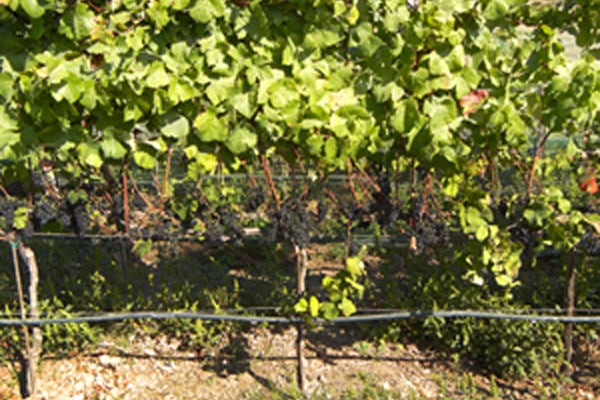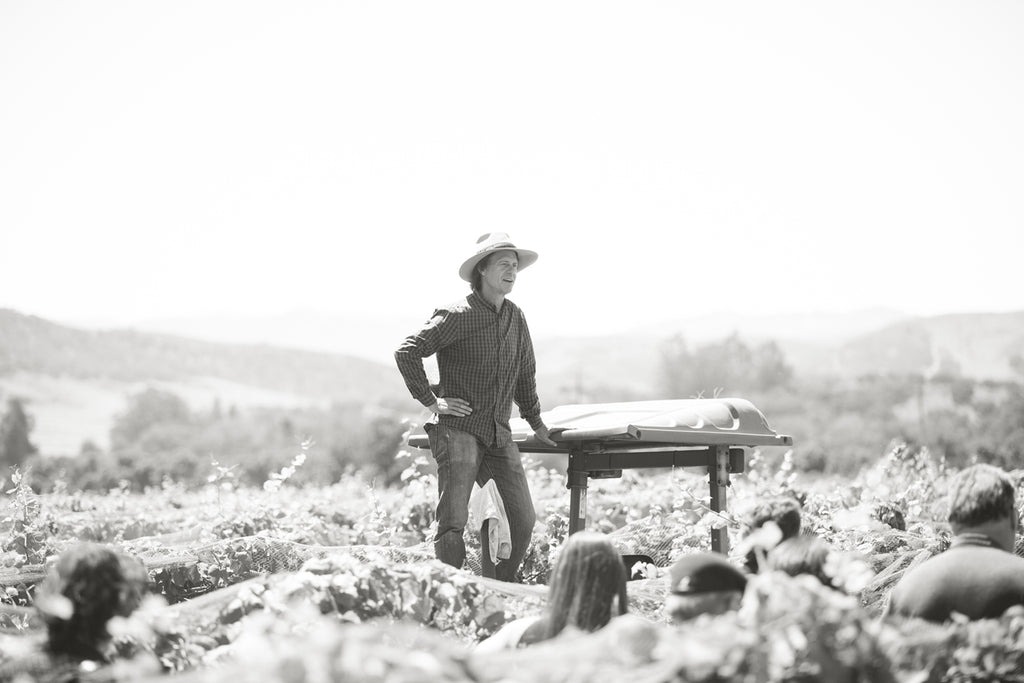The Headwaters of Revolutionary Farming™
Ladies & Gentlemen, It's Time for "Canopy Pivoting"
BRYAN BABCOCK
SPRING, 2012
After 35 years of farming, it’s finally time for my curtain call. Does this mean I’m finished? Bored with grapes? Is it time to hang it up?
Of course not. My curtain call is another way for me to say my epiphany. What it means is that I am building the foundation for a revolution in my farming. Simply put, it’s time to start working with nature. It’s time to let gravity and winds sculpt the vines for a change. It’s time to let the shoots fall down naturally like a curtain. Ladies and gentlemen, it’s time for “Canopy Pivoting!”
What we have witnessed in much of California wine growing over the last 20 years has been an orchestrated effort to orient the shoots of wine grapes up in a vertical position into a wire trellis; Vertical Shoot Positioning or VSP as it is called. I too, for years, thought this was the path to viticulture Mecca. It’s organized. It’s pretty. It makes good wine. Until recently, I was certain that my quasi-mechanized rendition of VSP was the deal. But after years of looking at it, I have come to a conclusion; VSP is a system that works against the forces of nature. What used to look pretty to me is starting to look more and more like a dinosaur.
While the rest of the Sta, Rita Hills, Santa Barbara County, and California are going to higher and higher density versions of VSP, for me, it's time to turn my world upside down. What I am going to do is raise my vine’s “platform”, i.e. the outwardly extending production canes, from a position that was about 2 ½ feet from the ground, up, to a position that will be about 5 feet from the ground. Whereas those canes used to be wrapped onto wires, now they will be suspended by little pedestals, and instead of the vine’s canopy being forced up into a trellis, it will be invited to spill in a downward direction, toward the ground. Gravity is no longer the enemy. And the breeze that comes out of the west every day will be the driving force behind a new breed of grapevine orthodontia.
Now, I know what you are thinking. If this simple idea is such a good one, why isn’t everyone already doing it? Why go to all the effort to put shoots up into a trellis when you can simply let them fall. Well, it has to do with organization. The problem with just letting things grow is the vine’s canopy turns into a big giant snarl of shoots with the crop struck underneath, devoid of sunlight and air. It’s a rot problem just waiting to happen. Indeed, the phrase that described most of our wine growing 25 years ago was “California Sprawl”, which was a nice way of saying “California Mess.” It was the reason that New World viticulture took a back seat to European viticulture. For California wines to be taken seriously, the firstthing that had to happen was for the farming to be taken seriously. Getting it organized and evolving out of the sprawl was a big step. By bringing in their trellises, growers got rid of the chaos. They brought sunlight and balance to their vines, thus improving the quality of wine up and down the state.
So the real question is, in the process of moving my platform up, if I still just let the vines grow, won’t I simply be creating a sprawl at a higher level? Just because it’s a little higher off the ground, isn’t a mess still a mess?
I don’t have the time or the space here to describe exactly how I am going to detangle the vines in my new system, but, suffice to say, if I could not ultimately visualize all this as a thing of beauty, then I would not be getting psyched up for the upheaval that I am about to unleash. I would not be lying in bed, night after night at 3 in the morning, visualizing that such a radical conversion could take me to such a crazy-good place. Believe me; I’ve wrestled with plenty of visions before, when, after about the third night, I start to see the cracks in my logic, and the reasons why those visions won’t work. But this time, after two years, I am on a line of thought that just seems to get better and better. Control, flow, symmetry, yield, simplicity; it’s all there.
Old school, traditional trellising. Notice the canopy is on top. Our new system. The canopy is mid to below the fruit line.

Old school, traditional trellising. Notice the canopy is on top.

Our new system. The canopy is mid to below the fruit line.
Over the next few years, you might start to hear me discuss things like, Complimentary Cane Pronation, Shoot Spilling, Pedestular Cane Suspension, Helicular Shoot Hotels, Canes In Space, Shade Throttling, Accentuated Disease & Frost Mitigation, Triangulated Bird Netting, etc. These are all new concepts that are starting to unfold within the overall system that I have named Canopy Pivoting. Easily put, “Curtain Farming”.
There are lots of new ideas, but in the end, it’s still farming. Hopefully it will be the kind of farming that leads to better wines and the maintenance of great prices. In a year or two I should have a number of blocks in the vineyard with vines that completely conform to the new system, and the invitation is always there for my customers to come see it.
Come see why my colleagues are going to call me crazy for at least the next decade.

"There are very few things in this crazy business a winemaker can count on year after year but I never have to think twice about where my most concentrated and pristine Pinot Noir lot will come from…Babcock Vineyards. Bryan's mind bending (and literally vine bending) approach to farming, along with his fearless desire to innovate results in world class Pinot Noir year after year."
-Mark Crawford Horvath, Winemaker/Partner, Crawford Family Wines
"Much like Randall Grahm of Bonny Doon fame, Babcock learned the rules in order not so much to break them, but to improve on them. He developed a unique “gravity-assisted” canopy system that allows vines to thrive, and his concept of “agristhetics” approaches the vineyard and its surrounds as a work of art. He is currently reforesting his property, whose estate vineyards have been suffering from Pierce’s Disease, and he’s been buying fruit from friends and neighbors to continue his work across a wide range of varietals from classic Syrah and Pinot Noir to more obscure grapes like Petit Verdot and Picpoul."
-Kim Westerman, Forbes
It's One Giant Leap for Wine Quality
UNDERSTAND FUNDAMENTALS
INTEGRATIVE VINIFICATION
GET CONTROL OF YOUR COSTS
GET CONTROL OF THE SUN
For consulting services in the field of winemaking or vineyard design + logistics
Contact Bryan Babcock
aisa@babcockwinery.com
805.588.5603
